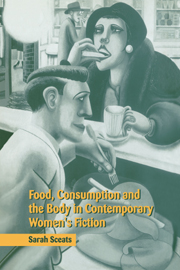Book contents
- Frontmatter
- Contents
- Acknowledgements
- Introduction
- Chapter 1 The food of love: mothering, feeding, eating and desire
- Chapter 2 Cannibalism and Carter: fantasies of omnipotence
- Chapter 3 Eating, starving and the body: Doris Lessing and others
- Chapter 4 Sharp appetites: Margaret Atwood's consuming politics
- Chapter 5 Food and manners: Roberts and Ellis
- Chapter 6 Social eating: identity, communion and difference
- Conclusion
- Notes
- Bibliography
- Index
Chapter 3 - Eating, starving and the body: Doris Lessing and others
Published online by Cambridge University Press: 22 September 2009
- Frontmatter
- Contents
- Acknowledgements
- Introduction
- Chapter 1 The food of love: mothering, feeding, eating and desire
- Chapter 2 Cannibalism and Carter: fantasies of omnipotence
- Chapter 3 Eating, starving and the body: Doris Lessing and others
- Chapter 4 Sharp appetites: Margaret Atwood's consuming politics
- Chapter 5 Food and manners: Roberts and Ellis
- Chapter 6 Social eating: identity, communion and difference
- Conclusion
- Notes
- Bibliography
- Index
Summary
Literary representations of the handling, cooking and consumption (or indeed non-consumption) of food and its effects embrace widely differing degrees of physicality. Compare, for example, Magwitch's pie, Mrs Ramsay's bœuf en daube and Proust's madeleine, which might crudely be characterised, respectively, as gut food, heart food and food in the head. To focus on the body as an eating, digesting, excreting organism draws attention to fundamental questions of survival, the nature of nourishment, and – more obliquely – subjectivity, autonomy and empowerment. It also evokes all manner of conflicting and contradictory cultural reverberations. This chapter will attempt to map some of these, exploring ideas and perceptions about the consuming and non-consuming body and the literary significance and function of eating in relation to embodiment. The discussion will cover a variety of novels, but the major part of the chapter is devoted to the writing of Doris Lessing.
To give a physical context to the discussion, it is worth beginning with a brief consideration of the body in western culture. Attitudes towards the body are complex and contradictory; in religion, education and the criminal justice system, for example, a guiding principle seems to have been the subjugation of the body as a means of disciplining the spirit.
- Type
- Chapter
- Information
- Publisher: Cambridge University PressPrint publication year: 2000



